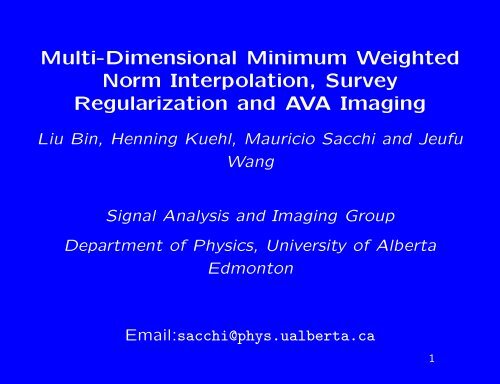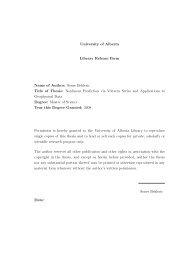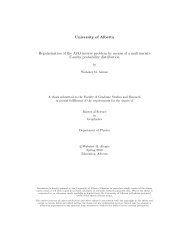Multi-Dimensional Minimum Weighted Norm Interpolation, Survey ...
Multi-Dimensional Minimum Weighted Norm Interpolation, Survey ...
Multi-Dimensional Minimum Weighted Norm Interpolation, Survey ...
You also want an ePaper? Increase the reach of your titles
YUMPU automatically turns print PDFs into web optimized ePapers that Google loves.
<strong>Multi</strong>-<strong>Dimensional</strong> <strong>Minimum</strong> <strong>Weighted</strong><br />
<strong>Norm</strong> <strong>Interpolation</strong>, <strong>Survey</strong><br />
Regularization and AVA Imaging<br />
Liu Bin, Henning Kuehl, Mauricio Sacchi and Jeufu<br />
Wang<br />
Signal Analysis and Imaging Group<br />
Department of Physics, University of Alberta<br />
Edmonton<br />
Email:sacchi@phys.ualberta.ca<br />
1
TOPICS<br />
Band-limited signal interpolation<br />
- <strong>Minimum</strong> norm reconstruction<br />
- <strong>Minimum</strong> weighed norm reconstruction<br />
- FFT+PCG<br />
<strong>Survey</strong> Regularization<br />
- 3D DSR Depth Imaging<br />
- 3D DSR AVA Imaging<br />
Future Directions<br />
2
MOTIVATION<br />
AVA imaging: Lack of amplitude fidelity due to uneven<br />
distribution of offsets in CDP bins<br />
Solution:<br />
- <strong>Survey</strong> Regularization<br />
- LS AVA Imaging<br />
- or, some combination of the above.<br />
3
TWO PROCESSING SCHEMES<br />
Include sampling considerations at the time of inverting<br />
an Earth model (LS Migration)<br />
- LS AVA Migration, H. Kuehl, UofA PhD Thesis, 2002<br />
- 3D AVA Wave equation migration, J. Wang, PhD in progress<br />
Interpolate then invert/migrate<br />
- Pre-stack data regularization, B. Liu, PhD in progress<br />
4
- Interpolate<br />
- Migrate<br />
<strong>Survey</strong> Regularization<br />
<strong>Minimum</strong> weigthed <strong>Norm</strong> <strong>Interpolation</strong><br />
5
Band-Limited <strong>Interpolation</strong><br />
1D Problem<br />
Complete data: x = [x1, x2, x3, . . . x M] T<br />
Observations: y = [x n(1) , x n(2) , x n(3) , . . . x n(N) ] T<br />
Sampling set: N = {n(1), n(2), n(3), . . . , n(N)}<br />
Sampling Operator: y = T ˜ x<br />
Ti,j = δ n(i),j<br />
TTT = ĨN , TT T˜ = ĨM ˜ ˜<br />
˜<br />
6
⎛<br />
⎜<br />
⎝<br />
Band-Limited <strong>Interpolation</strong><br />
Example<br />
x(2)<br />
x(3)<br />
x(5)<br />
⎞<br />
⎟<br />
⎠ =<br />
⎛<br />
⎜<br />
⎝<br />
0 1 0 0 0<br />
0 0 1 0 0<br />
0 0 0 0 1<br />
⎛<br />
⎞ ⎜<br />
⎟ ⎜<br />
⎠ ⎜<br />
⎝<br />
x(1)<br />
x(2)<br />
x(3)<br />
x(4)<br />
x(5)<br />
⎞<br />
⎟<br />
⎠<br />
7
Band-limited <strong>Interpolation</strong><br />
<strong>Minimum</strong> <strong>Norm</strong> Reconstruction<br />
Minimize ||x|| 2 W<br />
Subject to T ˜ x = y<br />
||x|| 2 W<br />
= <br />
k∈K<br />
X ∗ k X k<br />
|P k| 2<br />
X = [X0, X1, . . . , X M−1] T , X = F ˜ x<br />
8
Band-limited <strong>Interpolation</strong><br />
<strong>Minimum</strong> <strong>Norm</strong> Reconstruction<br />
||x|| 2 W<br />
= <br />
k∈K<br />
X ∗ k X k<br />
|P k| 2<br />
i) |P k| 2 are spectral domain weights with support and<br />
shape similar to the spectrum of the signal to interpolate<br />
ii) K indicates the region of spectral support of the<br />
signal<br />
iii) |P k| = 0 for k ∈ K<br />
9
Band-limited <strong>Interpolation</strong><br />
<strong>Minimum</strong> <strong>Norm</strong> Reconstruction<br />
Define the following diagonal matrices<br />
Λ k =<br />
Λ † k =<br />
<br />
<br />
|P k| 2 k ∈ K<br />
0 k ∈ K<br />
|P k| −2 k ∈ K<br />
0 k ∈ K<br />
||x|| 2 W = xH FH Λ˜<br />
†<br />
F˜ x<br />
˜<br />
= xH Q† x<br />
˜<br />
10
Band-limited <strong>Interpolation</strong><br />
<strong>Minimum</strong> <strong>Norm</strong> Reconstruction<br />
||x|| 2 W = xH FH Λ˜<br />
†<br />
F˜ x<br />
˜<br />
= xH Q† x<br />
˜<br />
† H<br />
= F˜ Λ˜ † F˜ is a circulant matrix<br />
i) Q<br />
˜<br />
ii) Q† is a band-limiting operator, it annihilates any spectral com-<br />
˜<br />
ponent k ∈ K.<br />
11
Band-limited <strong>Interpolation</strong><br />
<strong>Minimum</strong> <strong>Norm</strong> Reconstruction<br />
<strong>Minimum</strong> norm inversion, minimize cost function J:<br />
J = λ T (T ˜ x − y) + ||x|| 2 W<br />
ˆx = Q ˜<br />
TT (T˜ QTT ) −1 y .<br />
˜ ˜ ˜<br />
TT ) †<br />
˜<br />
i) In general we replace the inverse by (TQ ii) Assume a unit amplitude full-band operator<br />
˜ ˜ , Q<br />
˜<br />
T T<br />
ˆx = T (T˜ T ) −1 T<br />
y = T˜ y .<br />
˜ ˜<br />
= Ĩ −→<br />
12
y = T ˜ x<br />
⎛<br />
⎜<br />
⎝<br />
x(2)<br />
x(3)<br />
x(5)<br />
Band-limited interpolation<br />
<strong>Minimum</strong> norm reconstruction - Example<br />
⎞<br />
⎟<br />
⎠ =<br />
ˆx = TT y =<br />
˜<br />
⎛<br />
⎜<br />
⎝<br />
⎛<br />
⎜<br />
⎝<br />
0 1 0 0 0<br />
0 0 1 0 0<br />
0 0 0 0 1<br />
0<br />
x(2)<br />
x(3)<br />
0<br />
x(5)<br />
⎞<br />
⎟<br />
⎠<br />
⎛<br />
⎞ ⎜<br />
⎟ ⎜<br />
⎠ ⎜<br />
⎝<br />
Ooophs !!<br />
x(1)<br />
x(2)<br />
x(3)<br />
x(4)<br />
x(5)<br />
⎞<br />
⎟<br />
⎠<br />
13
Band-limited interpolation<br />
Reconstruction of noisy data<br />
Minimize cost function J:<br />
J = ||T ˜ x − y|| 2 + ρ 2 ||x|| 2 W<br />
14
Band-limited interpolation<br />
Reconstruction of noisy data<br />
Or, solve the equivalent problem:<br />
<br />
T ˜<br />
ρW ˜<br />
<br />
x ≈<br />
<br />
y<br />
0<br />
W = FH Λ˜ 1/2 F˜<br />
˜ ˜<br />
<br />
.<br />
i) The augmented matrix of the problem is rank deficient<br />
ii) Solve it by choosing, among all possible least-squares solu-<br />
tions, the one with minimum Euclidean norm<br />
iii) SVD or CG<br />
15
Band-limited interpolation<br />
Reconstruction of noisy data - PCG<br />
Change of variable: x = Wz<br />
<br />
T W<br />
˜ ρ˜<br />
†<br />
<br />
z ≈<br />
<br />
y<br />
0<br />
<br />
.<br />
i) The trade-off parameter can be set to ρ = 0 and use the num-<br />
ber of iterations in the CG method play the role of regularization<br />
parameter (Hansen, 1998)<br />
ii) Solve T W† z ≈ y and stop the algorithm when a target misfit<br />
˜ ˜<br />
is achieved<br />
16
Band-limited interpolation<br />
Reconstruction of noisy data - PCG<br />
Weights can be estimated in an iterative manner using the Mod-<br />
ified Peridogram<br />
|P k| 2 =<br />
Ll=−L w l|X k−l| 2 , k ∈ K<br />
0 , k ∈ K<br />
or, adopt a non-iterative strategy (Herrmann et al., 2000).<br />
i) The weights |Pk| 2 required to interpolate spatial data at a tem-<br />
poral frequency f can be estimated from the already interpolated<br />
data at frequency f − ∆f.<br />
ii) Helps to reduce alias (mild alias!)<br />
17
T ˜ W ˜<br />
Band-limited interpolation - 2D case<br />
Reconstruction of noisy data - PCG<br />
† z ≈ y<br />
W = (Fu ⊗ Fv) ˜ ˜ ˜ H Λ1/2 (F˜ u ⊗ Fv) .<br />
˜ ˜<br />
i) The Kronecker tensor product is not needed<br />
ii) Inner products required by PCG are computed in the flight<br />
iii) Generalization to ND is straightforward<br />
18
EXAMPLE 1 - MWNI vs MNI<br />
19
Time (s)<br />
Time (s)<br />
Time (s)<br />
0<br />
0.2<br />
0.4<br />
0.6<br />
0.8<br />
1<br />
1.2<br />
0<br />
0.2<br />
0.4<br />
0.6<br />
0.8<br />
1<br />
1.2<br />
0<br />
0.2<br />
0.4<br />
0.6<br />
0.8<br />
1<br />
1.2<br />
(a)<br />
100 200 300 400 500<br />
Offset (m)<br />
(c)<br />
100 200 300 400 500<br />
Offset (m)<br />
(e)<br />
100 200 300 400 500<br />
Offset (m)<br />
Time (s)<br />
Time (s)<br />
Time (s)<br />
0<br />
0.2<br />
0.4<br />
0.6<br />
0.8<br />
1<br />
1.2<br />
0<br />
0.2<br />
0.4<br />
0.6<br />
0.8<br />
1<br />
1.2<br />
0<br />
0.2<br />
0.4<br />
0.6<br />
0.8<br />
1<br />
1.2<br />
(b)<br />
100 200 300 400 500<br />
Offset (m)<br />
(d)<br />
100 200 300 400 500<br />
Offset (m)<br />
(f)<br />
100 200 300 400 500<br />
Offset (m)<br />
a) True, b) Decimated, c) MWNI reconstruction, d) MWNI error<br />
panel, e) MNI reconstruction, and f) MWNI error panel.<br />
20
EXAMPLE 2 - Gulf of Mexico CSG<br />
- MWNI is used to recover missing data (gaps) and<br />
to interpolate (∆hnew = 1/2∆h old)<br />
21
EXAMPLE 2 - Gulf of Mexico CSG<br />
(a)<br />
(b)<br />
Time (s)<br />
Time (s)<br />
3.0<br />
3.2<br />
3.4<br />
3.6<br />
3.8<br />
4.0<br />
4.2<br />
4.4<br />
3.0<br />
3.2<br />
3.4<br />
3.6<br />
3.8<br />
4.0<br />
4.2<br />
4.4<br />
-4800 -4600 -4400 -4200 -4000<br />
Offset (m)<br />
-3800 -3600 -3400 -3200 -3000 -2800<br />
-4800 -4600 -4400 -4200 -4000<br />
Offset (m)<br />
-3800 -3600 -3400 -3200 -3000 -2800<br />
22
EXAMPLE 3 - Marmousi<br />
1 - Data are decimated in both receicer/shot<br />
2 - MWNI is used to recover ”decimated” positions<br />
23
Source positions (m)<br />
3600<br />
3500<br />
3400<br />
3300<br />
3200<br />
3100<br />
3000<br />
EXAMPLE 3 - Marmousi<br />
Known<br />
Unknown<br />
500 1000 1500 2000 2500 3000 3500<br />
Receiver positions (m)<br />
Data used in the numerical experiment<br />
24
(a)<br />
Time (s)<br />
0<br />
0.5<br />
1.0<br />
1.5<br />
2.0<br />
2.5<br />
EXAMPLE 3 - Marmousi<br />
0 50 100<br />
Trace Number<br />
150 200 250<br />
Shots at source positions 3075, 3100, 3125 m.<br />
25
(b)<br />
Time (s)<br />
0<br />
0.5<br />
1.0<br />
1.5<br />
2.0<br />
2.5<br />
EXAMPLE 3 - Marmousi<br />
0 50 100<br />
Trace Number<br />
150 200 250<br />
Shots at source position 3075, 3100, 3125 m after decimation.<br />
26
(c)<br />
Time (s)<br />
0<br />
0.5<br />
1.0<br />
1.5<br />
2.0<br />
2.5<br />
EXAMPLE 3 - Marmousi<br />
0 50 100<br />
Trace Number<br />
150 200 250<br />
MWNI Reconstuction, source position 3075, 3100, 3125 m.<br />
27
(d)<br />
Time (s)<br />
0<br />
0.5<br />
1.0<br />
1.5<br />
2.0<br />
2.5<br />
EXAMPLE 3 - Marmousi<br />
0 50 100<br />
Trace Number<br />
150 200 250<br />
Error panel: Recostructed shots minus original shots. 28
EXAMPLE 4 - 3D WCB<br />
Post stack <strong>Interpolation</strong> and SNR Enhancement<br />
29
EXAMPLE 4 - 3D WCB<br />
(a)<br />
(b)<br />
(c)<br />
a) Original Post-stack cube. b) Decimated cube. c)<br />
reconstucted cube with MWNI.<br />
30
Time (s)<br />
0.8<br />
1.0<br />
1.2<br />
1.4<br />
1.6<br />
1.8<br />
2.0<br />
EXAMPLE 4 - 3D WCB<br />
(a) (b) (c)<br />
a) Original. b) Reconstructed with MWNI. c) error. 31
Time (s)<br />
0.8<br />
1.0<br />
1.2<br />
1.4<br />
1.6<br />
1.8<br />
2.0<br />
EXAMPLE 4 - 3D WCB<br />
(a) (b) (c)<br />
a) Original. b) Reconstructed with MWNI. c) error. 32
EXAMPLE 5 - WCB Sparse 3D (Erskine)<br />
Veritas<br />
33
EXAMPLE 5 - WCB Sparse 3D (Erskine)<br />
y−cdp bin<br />
10<br />
20<br />
30<br />
40<br />
20 40 60 80<br />
x−cdp bin<br />
100 120 140<br />
Number of Offets in cdp bin<br />
0 5 10 15 20 25 30 35 40 45<br />
<strong>Interpolation</strong> to a regular xm, ym, hx grid<br />
is required before Common Azimuth AVP Wave Equation Migration<br />
(Kuehl and Sacchi, SEG2001; Biondi et. al, EAGE2002)<br />
34
Time (sec)<br />
0<br />
0.5<br />
1.0<br />
1.5<br />
EXAMPLE 5 - WCB Sparse 3D (Erskine)<br />
0 50<br />
Trace number<br />
100 150 200<br />
Inline 6, Crossline 15 to 18<br />
Time (sec)<br />
0<br />
0.5<br />
1.0<br />
1.5<br />
0 50<br />
Trace number<br />
100 150 200<br />
Left: Original. Right: After MWNI<br />
35
EXAMPLE 5 - WCB Sparse 3D (Erskine)<br />
Depth (km)<br />
0<br />
0.5<br />
1.0<br />
1.5<br />
Ray parameter (mu s/m)<br />
0 300 600 900<br />
Depth (km)<br />
0<br />
0.5<br />
1.0<br />
1.5<br />
Ray parameter (mu s/m)<br />
0 300 600 900<br />
CIG (AVP) gathers. Left: No interpolation. Right: After MWNI<br />
36
Depth (m)<br />
0<br />
500<br />
1000<br />
1500<br />
EXAMPLE 5 - WCB Sparse 3D (Erskine)<br />
Offset (m)<br />
0 1000 2000 3000 4000<br />
Depth (m)<br />
0<br />
500<br />
1000<br />
1500<br />
0 500<br />
Offset (m)<br />
1000 1500<br />
Migration [NO intepolation] Left: inline 36. Right: xline 71<br />
37
Depth (m)<br />
0<br />
500<br />
1000<br />
1500<br />
EXAMPLE 5 - WCB Sparse 3D (Erskine)<br />
Offset (m)<br />
0 1000 2000 3000 4000<br />
Depth (m)<br />
0<br />
500<br />
1000<br />
1500<br />
0 500<br />
Offset (m)<br />
1000 1500<br />
Migration after MWNI. Left: inline 36. Right: xline 71<br />
38
EXAMPLE 5 - WCB Sparse 3D (Erskine)<br />
10<br />
20<br />
30<br />
40<br />
10<br />
20<br />
30<br />
40<br />
20 40 60 80 100 120 140<br />
20 40 60 80 100 120 140<br />
Depth slices [NO interpolation] Top: z = 1420 m. Bottom: z = 1620 m<br />
39
EXAMPLE 5 - WCB Sparse 3D (Erskine)<br />
10<br />
20<br />
30<br />
40<br />
10<br />
20<br />
30<br />
40<br />
20 40 60 80 100 120 140<br />
20 40 60 80 100 120 140<br />
Depth slices after interpolation. Top: z = 1420 m. Bottom: z = 1620 m<br />
40
EXAMPLE 5 - WCB Sparse 3D (Erskine)<br />
All AVP Gathers<br />
www-geo.phys.ualberta.ca/~ sacchi/movies.html<br />
41
Summary<br />
i) MWNI: Efficient and simple (PCG and FFT)<br />
ii) Better than MNI at the time of handling large gaps<br />
iii) Simple to implement in any domain<br />
Near future work:<br />
i) Compare with AVA gathers obtained via LS migration<br />
ii) Continue with amplitude fidelity studies (Kuehl and<br />
Sacchi, Geophysis 03)<br />
iii) Alternatives (Radon, Azimuth Moveout, etc) 42
References [<strong>Interpolation</strong>]<br />
Cabrera S.D. and Parks T.W., 1991, Extrapolation and spectrum estimation<br />
with iterative weighted norm modification: IEEE Trans. Signal Processing,<br />
39, 842-850.<br />
Duijndanm A.J.W., Schonewille M., and Hindriks K., 1999, Reconstruction of<br />
seismic signals, irregularly sampled along on spatial coordinate: Geophysics,<br />
64, 524-538.<br />
Hansen P.C., 1998, Rank-Deficient and Discrete Ill-Posed Problems: SIAM.<br />
Herrmann, P., Mojesky, T., Magesan, M. and Hugonnet, P., 2000, De-aliased,<br />
high-resolution Radon transforms: 70th Ann. Internat. Mtg: Soc. of Expl.<br />
Geophys., 1953-1956.<br />
Sacchi, M. D. and Ulrych, T. J., 1996, Estimation of the discrete Fourier<br />
transform, a linear inversion approach: Geophysics, 61, 1128-1136.<br />
Zwartjes P., Duijndam A.J.W., 2000, Optimizing reconstruction for sparse<br />
spatial sampling. 70th Ann. Internat. Mtg.: Soc. of Expl. Geophys.,<br />
Expanded Abstracts, 2162–2165.<br />
43
Acknowledgments<br />
The Signal Analysis and Imaging Group at the University of Alberta<br />
would like acknowledge financial support from the following<br />
companies and agencies:<br />
Geo-X Ltd<br />
Encana Ltd<br />
Veritas Geo-services<br />
Schlumberger Foundation<br />
Natural Sciences and Engineering Research Council of Canada<br />
Alberta Department of Energy.<br />
We also thank Dr S. Cheadle (Veritas) for providing the seis-<br />
mic data for the AVA tests.<br />
44









